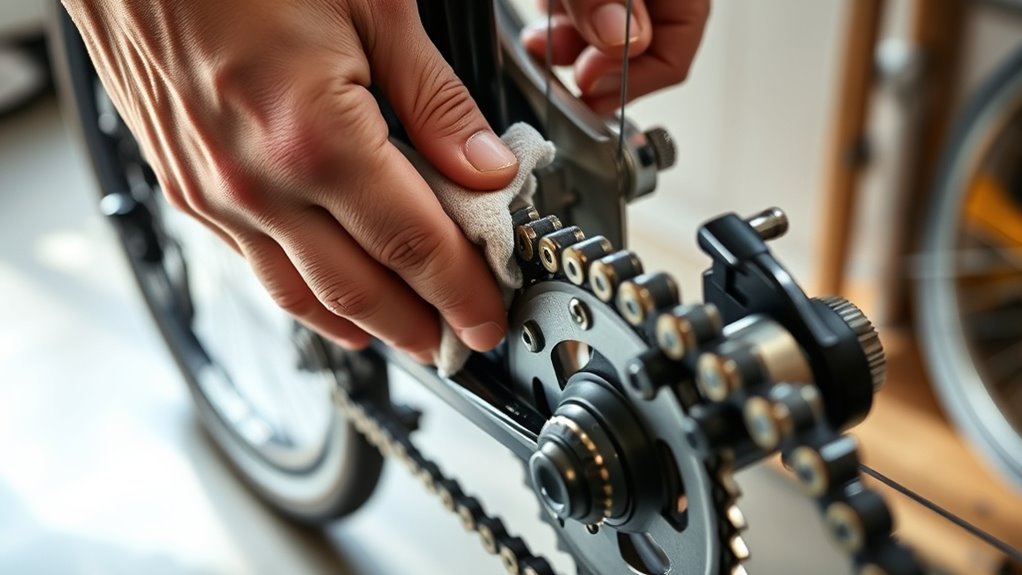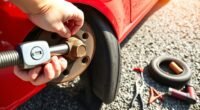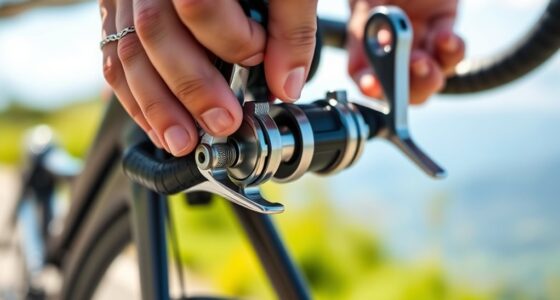To keep your bike in top shape, regularly clean it with water and mild soap, focusing on removing dirt and grime. Lubricate moving parts like the chain and gears after cleaning, applying lubricant carefully to prevent rust and ensure smooth riding. Check and tighten bolts and fasteners using a torque wrench if needed, making sure everything stays secure. For more tips on how to stay safe and organized, keep exploring these essential maintenance steps.
Key Takeaways
- Regularly clean the bike frame and components with mild soap and water, avoiding high-pressure rinses.
- Thoroughly degrease and lubricate the chain after cleaning to ensure smooth operation and prevent rust.
- Inspect and tighten all bolts and fasteners, using a torque wrench to match manufacturer recommended specifications.
- Check brake pads for wear and replace if they’re thinning or uneven, ensuring optimal braking performance.
- Schedule routine maintenance, including professional tune-ups twice a year, to keep your bike in safe and efficient condition.
Gathering the Necessary Tools and Supplies
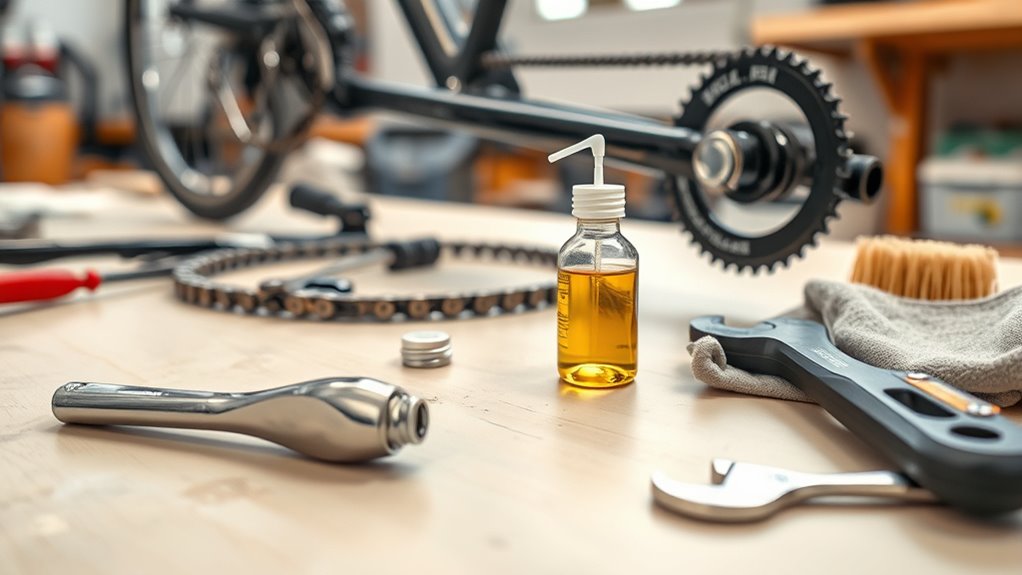
Before you begin maintaining your bicycle, it’s important to gather all the necessary tools and supplies. Start by organizing your tools to guarantee easy access and efficient work. Good tool organization helps prevent losing small parts and saves time during maintenance.
Organize your tools for easy access and efficient, frustration-free bike maintenance.
Think about your bike storage setup—choose a clean, well-lit space where you can lay out everything comfortably. Collect essential items like a set of Allen wrenches, screwdrivers, tire levers, and a bike pump. Keep lubricants and cleaning rags nearby as well.
Having everything ready and neatly stored reduces frustration and streamlines the process. Proper tool organization and a designated bike storage area make maintenance safer, more efficient, and more enjoyable.
This preparation lays a solid foundation for effective bike care.
How to Properly Clean Your Bicycle

Cleaning your bicycle regularly keeps it running smoothly and extends its lifespan. Start by rinsing the frame with water to remove dirt and grime. Use a soft brush or sponge with mild soap to clean the frame, avoiding harsh chemicals that could damage paint or decals. For chain maintenance, apply a degreaser to the chain and scrub it with a brush to remove built-up grime. Rinse thoroughly and dry with a clean cloth. Be sure to clean around gears, derailleurs, and brake components as well. Avoid soaking the bike or using high-pressure water, which can force dirt into bearings. Keep your bicycle clean to prevent rust and ensure smooth operation. Regular cleaning also helps maintain optimal suction power of your bike’s components, ensuring a safer and more efficient ride. Additionally, a clean bike reduces the risk of potential damage caused by accumulated dirt and corrosion. Proper cleaning makes future maintenance easier and keeps your ride looking great. Incorporating preventive maintenance routines can further prolong the lifespan of your bicycle components.
The Importance of Lubricating Moving Parts
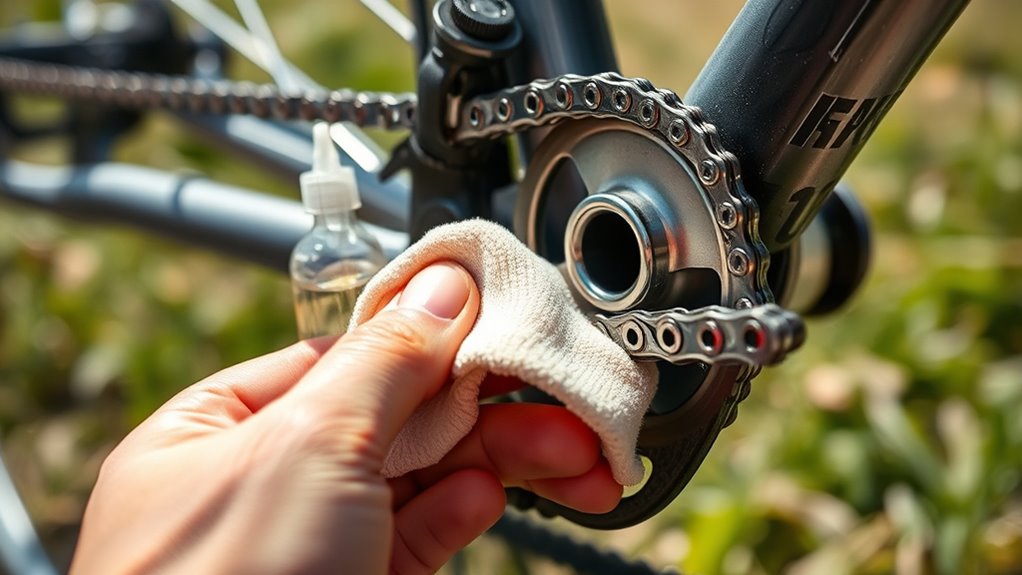
Lubricating your bike’s moving parts helps reduce friction and prevents excessive wear, keeping everything running smoothly.
It also guards against rust formation that can weaken components over time. When you keep parts well-lubricated, your bike operates effortlessly and lasts longer.
Reduces Friction and Wear
Applying lubricant to your bike’s moving parts is essential because it minimizes friction, allowing components to glide smoothly. Proper lubrication reduces wear on parts like the chain, gears, and brake mechanisms, extending their lifespan. When your chain is well-lubricated, it maintains peak tension, preventing slippage and uneven wear. Additionally, smooth operation of brake adjustment components ensures safety and efficiency. Regularly applying lubricant keeps these parts functioning seamlessly, reducing the need for frequent repairs. Use the table below to understand key components involved:
| Component | Benefit |
|---|---|
| Chain | Reduced friction, longer life |
| Gears | Smooth shifting |
| Brake levers & cables | Improved responsiveness |
| Pivot points | Less wear, easier movement |
| Chain tension & brake adjustment | Maintains safe operation |
Prevents Rust Formation
To prevent rust from forming on your bike’s moving parts, regular lubrication is essential. Proper lubrication acts as a barrier against moisture, helping with rust prevention and corrosion control. Keeping your bike well-maintained with proper lubrication can significantly extend its lifespan and ensure smooth operation. When you apply lubricant, you protect metal surfaces from exposure to water and dirt that can accelerate rust. This simple step extends your bike’s lifespan and keeps it functioning smoothly. Additionally, choosing the right lubricant type for each component ensures optimal protection. Regularly inspecting your bike for signs of wear and tear can help you address issues early and maintain a safe riding experience. Understanding maintenance routines can help you maintain a more harmonious connection with your bike, making maintenance a more mindful and rewarding activity.
Ensures Smooth Operation
Keeping your bike’s moving parts well-lubricated guarantees they operate smoothly and efficiently. Regular lubrication reduces friction, preventing unnecessary wear and tear. You should also pay attention to tuning aspects like chain tension; a properly tensioned chain moves smoothly without slipping or skipping. When lubricating, make sure the chain is clean to avoid dirt buildup that can hinder performance. Additionally, check gear alignment; well-aligned gears shift effortlessly, enhancing your ride. Proper lubrication also helps keep other moving parts, like brake pivots and derailleurs, functioning properly. Using quality automotive lubricants designed for bikes can extend the lifespan of these components. Incorporating regular maintenance practices ensures your bicycle remains in optimal condition and prolongs its usability. Staying aware of e-commerce demands and technological advances can help you choose the best lubrication products for your bike. Understanding sound design principles can also inspire quieter and more efficient component operation by minimizing noise and vibration.
Step-by-Step Guide to Lubricating Your Bike
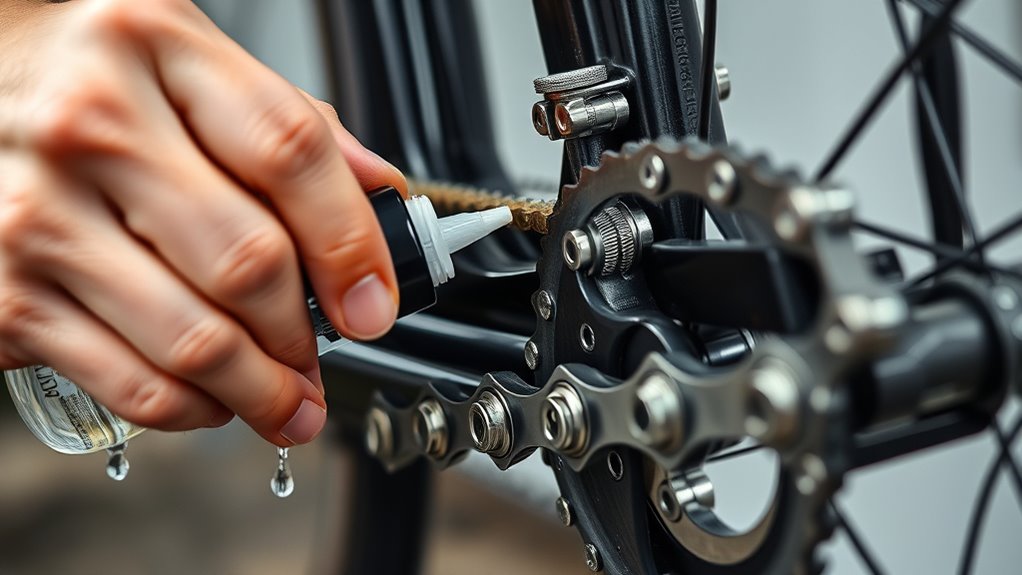
Lubricating your bike is essential for smooth rides and preventing rust, but it’s a simple process if you follow the right steps. Proper chain maintenance and effective lubrication techniques ensure your bike runs smoothly. Using a high-quality, appropriate lubrication helps extend the lifespan of your components and improves riding performance. To get started:
- Clean the chain thoroughly to remove dirt and grime
- Apply lubricant directly to each chain link
- Spin the pedals backward to distribute the lubricant evenly
- Wipe off excess to prevent dirt buildup
- Regularly reapply after wet or muddy rides
- Employing smart maintenance tools can help you monitor and optimize your bike’s lubrication schedule for better performance. Using the correct type of lubricant minimizes the attraction of dirt and debris. Use a bike-specific lubricant and avoid over-lubricating, which can attract dirt. Focus on the chain, derailleurs, and pivot points. Proper lubrication reduces wear, noise, and friction, making your rides more efficient. Keep this routine consistent for ideal bike performance. Regular maintenance with effective cleaning methods can further enhance your bike’s longevity and performance.
Checking and Tightening Bolts and Fasteners
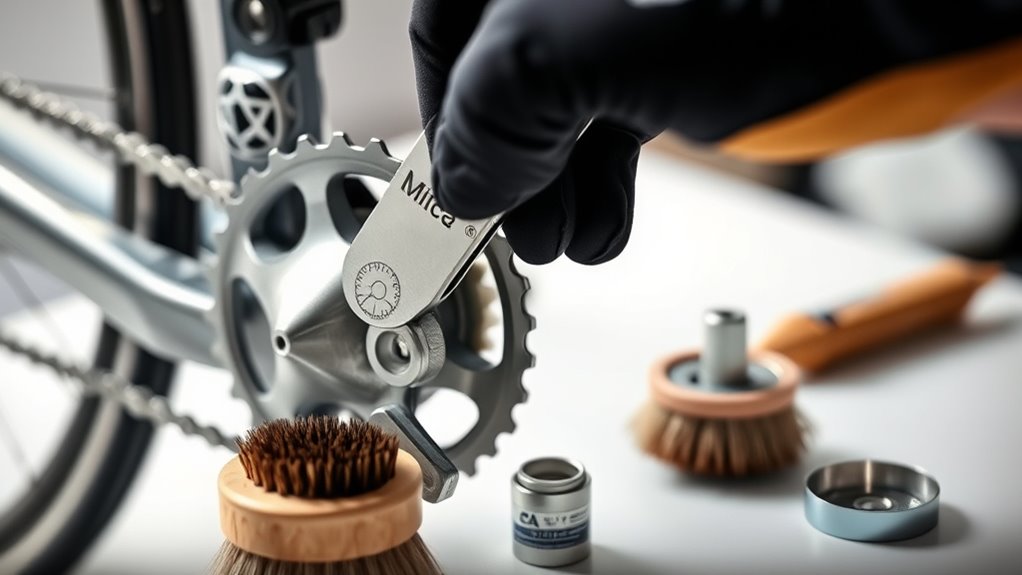
Regularly checking and tightening your bike’s bolts and fasteners is essential for safe and reliable rides. Start by inspecting each bolt for looseness or corrosion, performing a thorough bolt inspection. Use a torque wrench to ensure each fastener matches the recommended torque specifications for your bike. Over-tightening can damage components, while under-tightening can cause parts to loosen during rides. Pay special attention to critical areas like handlebars, seat posts, and stem bolts. If you notice any stripped threads or damaged fasteners, replace them immediately. Keep a set of basic tools handy to tighten bolts as needed. Regular maintenance of bolt tightness keeps your bike stable, prevents accidents, and extends the lifespan of your components. Proper bolt torque ensures that fasteners are tightened correctly without risking damage. Additionally, understanding bike maintenance principles helps maintain overall safety and performance. Incorporating regular inspections into your routine can further prevent potential issues before they arise. Performing these checks regularly also helps you become more familiar with your bike’s component wear and preventative care, allowing for early detection of potential problems.
Identifying Common Wear and Damage
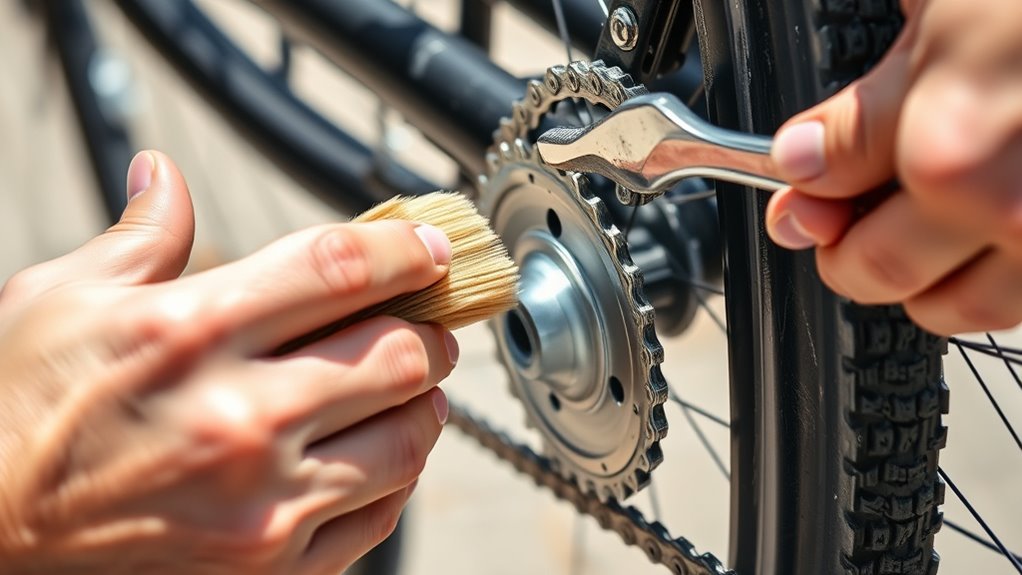
You should regularly check your brake pads for thinning or uneven wear since they influence stopping power.
Inspect your tire tread depth to guarantee it’s sufficient for safe riding, especially on rough surfaces.
Recognizing these signs early helps prevent accidents and costly repairs down the line.
Additionally, verifying your bike’s alignment and frame integrity can help identify structural issues that may compromise safety.
Brake Pad Wear
Brake pad wear is a common issue that directly affects your bike’s stopping power and safety. Regular brake pad inspection helps catch signs of damage early. Look for uneven wear, cracks, or glazing on the surface.
If the pad material is worn down to the metal backing, it’s time for brake pad replacement. Keep an eye out for:
- Thinned brake pads
- Visible cracks or chips
- Glazed or shiny surfaces
- Unusual noises when braking
- Reduced braking effectiveness
Addressing these issues promptly ensures your brakes work reliably. If you notice significant wear or damage, replacing your brake pads is vital for safety.
Regular maintenance keeps your bike performing at its best and prevents more costly repairs down the line.
Tire Tread Depth
How can you tell if your bicycle tires are wearing out or damaged? Check the tire tread for signs of wear. The tread depth indicates how much rubber remains; if it’s worn down close to the casing, your tire’s grip and safety decrease. Use a tread depth gauge or a simple coin test—insert a penny into the tread with Lincoln’s head facing down. If you see the top of Lincoln’s head, it’s time to replace the tire.
Inspect for cuts, cracks, or embedded debris that can compromise the tire’s integrity. Consistently monitoring the tread depth helps prevent flats and accidents. Maintaining proper tire condition ensures a smoother ride and longer-lasting tires.
Regular checks are essential for safe, efficient cycling.
Creating a Regular Maintenance Schedule
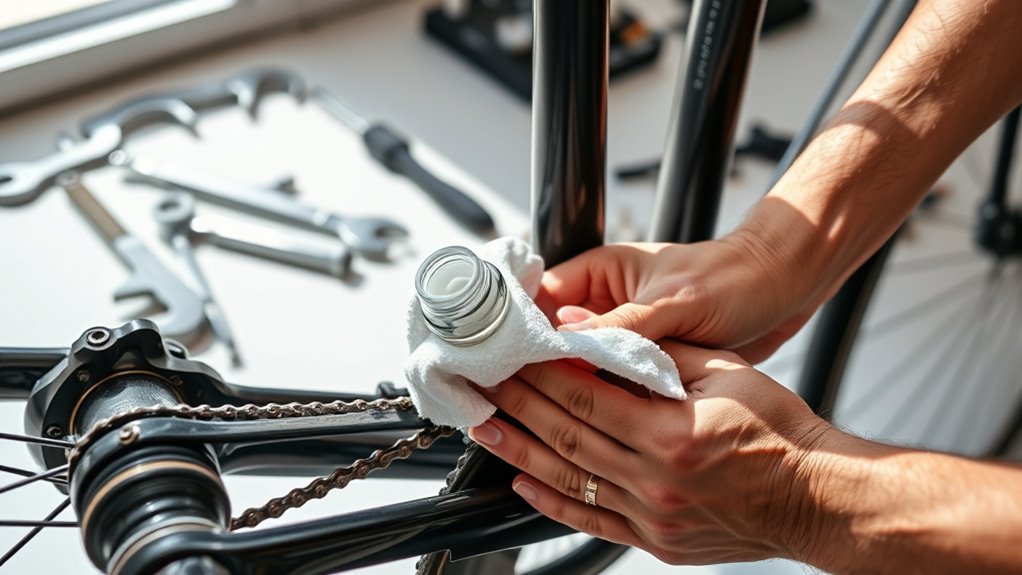
Establishing a regular maintenance schedule is essential to keep your bicycle in ideal condition and prevent costly repairs. By sticking to a routine, you guarantee all parts stay in top shape and you catch issues early.
Incorporate seasonal scheduling to adapt your bike maintenance based on weather and riding frequency.
Here are key points to contemplate:
- Check tire pressure and tread before each ride
- Lubricate chains regularly, especially in wet seasons
- Inspect bolts and fasteners monthly
- Clean your bike after muddy or rainy rides
- Schedule professional tune-ups at least twice a year
A consistent schedule helps you stay on top of bike maintenance, reduces downtime, and prolongs your bike’s lifespan. Make it a habit, and your rides will stay smooth and safe year-round.
Tips for Safe and Effective Bicycle Care
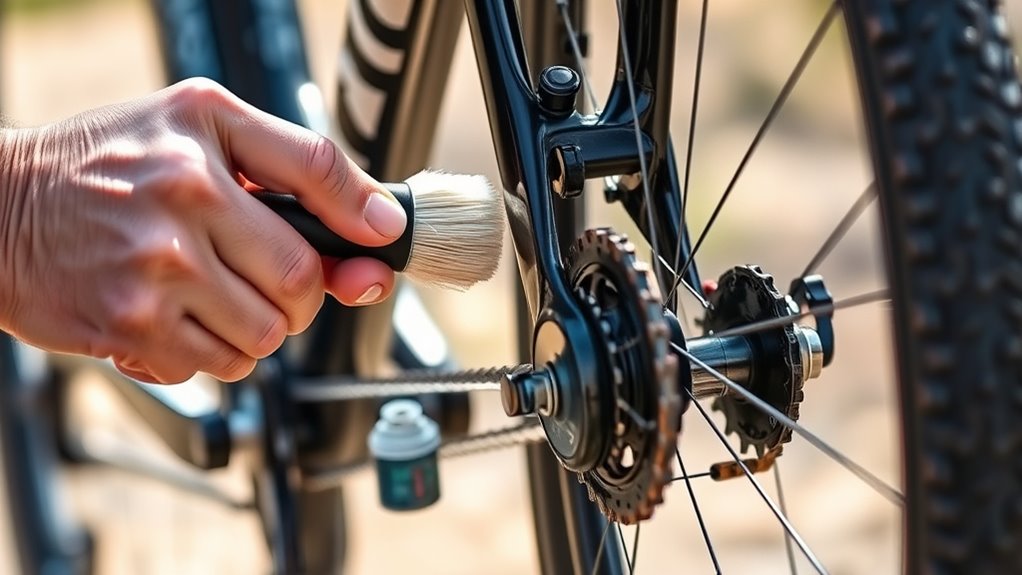
To guarantee your bicycle remains safe and performs well, it’s essential to follow effective care practices. Regularly inspect your bike accessories, such as lights, reflectors, and brakes, to assure they’re functioning properly.
Proper riding techniques, like avoiding sudden stops and maintaining a steady speed, reduce wear and tear.
Keep your bike clean and lubricated to prevent rust and confirm smooth operation.
Always check bolts and fasteners before rides to avoid accidents.
When adjusting your bike, use the right tools and follow manufacturer instructions.
Store your bicycle in a dry, sheltered place to prevent damage.
Frequently Asked Questions
How Often Should I Replace Bike Lubricants for Optimal Performance?
You should replace bike lubricants when you notice chain wear increasing or if the lubricant no longer beads up or penetrates well. Typically, this means reapplying every few rides or when riding in wet conditions, as lubricant longevity varies with weather and riding style.
Regularly check your chain and apply fresh lubricant to reduce wear and keep your bike running smoothly. Don’t wait until performance drops considerably; stay proactive with maintenance.
What Are the Signs of Loose Bolts That Need Tightening?
Like a ship’s crew senses a leak, you should notice signs of loose fittings and bolt tightness. If you feel your handlebars wobble, your saddle shifts, or you hear creaking, those are clues bolts need tightening.
Also, look for any visible movement or rust. Regularly checking for these signs keeps your ride smooth and safe, preventing minor issues from turning into major problems on the road.
Can I Use Household Cleaning Products on My Bicycle?
You might be tempted to use household cleaner on your bike, but it’s not recommended. Household cleaners contain chemicals that can damage your bicycle’s components or finish.
Always prioritize chemical safety and opt for bike-specific cleaning products. These are formulated to clean effectively without harming your bike’s materials.
Using proper products guarantees your bike stays in good shape and lasts longer, avoiding unnecessary damage caused by harsh household cleaners.
How Do I Prevent Rust on Bike Components?
To prevent rust on your bike components, you should focus on rust prevention and corrosion control. Keep your bike dry and store it in a sheltered place to avoid moisture exposure.
Regularly clean and dry your bike, especially after riding in wet conditions. Apply a protective lubricant or rust inhibitor to metal parts.
Check for any signs of corrosion. These steps will help extend your bike’s lifespan and keep it running smoothly.
What Safety Precautions Should I Take During Maintenance?
When performing maintenance, you should prioritize safety by wearing protective gear like gloves and goggles to prevent injuries. Make certain your workspace is well-lit, organized, and free of hazards to avoid accidents.
Keep tools properly stored when not in use, and work on a stable surface. Always follow manufacturer instructions, and be cautious around moving parts.
Taking these precautions helps you stay safe and avoid mishaps during bike upkeep.
Conclusion
By regularly cleaning, lubricating, and checking your bike, you keep it running like a lightning-fast superhero on wheels. Skipping these steps is like inviting chaos to take over your ride—nothing short of a disaster waiting to happen. Stay proactive with maintenance, and your bicycle will reward you with smooth rides and fewer breakdowns. Remember, a well-maintained bike isn’t just transportation; it’s your trusty steed ready to conquer any adventure that comes your way.
